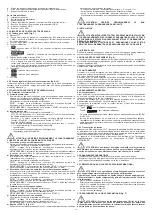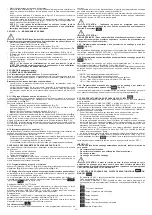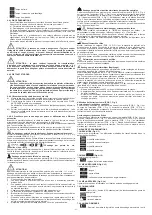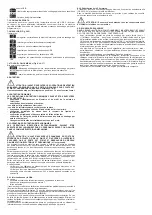
- 8 -
supply point and adjust the pressure using the reducer knob until the manometer
shows a value close to 8 bar (116 psi).
6.1.1.1 Adjusting and fixing the “C” clamp arm
This operation must only be carried out if the arm moves horizontally even after having
been locked as explained in paragraph 5.8
(Fig. Q)
For this operation proceed as follows:
- Release the arm by rotating the release lever (Fig. R);
- Loosen the dowel (Fig. S-1) and tighten the ring nut (Fig. S-2) by one-eighth of a
turn (approx. 45 degrees);
- Lock the ring nut, tightening the locking dowel (Fig. S-1);
- Lock the arm, following the operation shown in Fig. T.
This operation may need to be carried out several times, either tightening or loosening
the ring nut
(Fig. S-2)
, until the arm is locked horizontally and the locking lever, using
rotational power that is suitable for manual release, simultaneously closes at the stop
created by the reference plug
(Fig. T-1)
.
NOTE: when the operation ends, the lever must be against the end stop plug
(Fig.
T-1)
. This position guarantees that the “C” arm is locked mechanically and therefore
safe.
6.1.2 Main switch at the “ I ” position
The following checks must be carried out before doing any spot welding, and with the
main switch at “I” (ON).
Clamp electrode alignment:
- Place a shim having the same thickness as the panels to be spot welded between
the electrodes; make sure the electrodes, which are now “squeezing” the panels
(see paragraph 6.2.2), are aligned.
- If necessary, make sure that the arm is correctly fixed (see previous paragraphs).
6.2 ADJUSTING THE SPOT WELDING PARAMETERS
The parameters that determine the diameter (section) and mechanical seal of the
spot are:
- Power applied by the electrodes.
- Spot welding current.
- Spot welding time.
If the operator does not have specific experience, it is best to try some spot welding
on pieces of panel with the same thickness and of the same quality as the ones to be
spot welded.
6.2.1 Setting the arm and the electrode
Press the “START” key (Fig. U-1) and set the arm among those available (Fig. U-2)
turning the central knob (Fig. C-5).
6.2.2 Adjustment of force and approach function (pneumatic clamp only)
Adjustment of force takes place in automatic or manual mode (using the pressure
regulator on the air unit).
Setting the automatic mode (default setting) or manual mode allows you to choose
from the main menu selecting the icon
and then the icon
as in the
figures U-3-4.
Automatic adjustment “AUTO daN”:
Choosing “AUTO daN”, you can set the desired value of the force expressed in “deca
Newton” using the “MANUAL” mode (Fig. U-5).
In “SMART AUTOSET” and “EASY” mode, during the spot welding cycle, the force of
the electrodes is automatically adjusted.
Manual adjustment:
Choosing “no AUTO daN” you can set the force value manually on the pressure
regulator (Fig. B-10).
During the spot welding cycle, the force of the electrodes will be manually regulated
according to the procedure described above.
Approach function
:
It allows approach of the electrodes with the force set without supplying current.
You can approach the electrodes in any spot welding program with the following
procedure (double click):
Press and release the clamp button and then immediately press the button. The clamp
approaches and keeps closed the electrodes up to subsequent release of the button.
The led in clamp flashes.
WARNING: using the protective gloves can make it difficult to
approach by double clicking. It is therefore advisable to select the approach
function
.
WARNING!
RESIDUAL RISK! This operating mode also causes the residual risk of crushing
of the upper limbs: take all necessary precautions (see safety chapter).
6.2.3 Automatic setting the spot welding parameters
(Fig. U-6)
The spot welding parameters are all set automatically by the machine: “SMART
AUTOSET” mode. You need that both the plugs on the clamps C are connected to
the machine (Fig. F).
6.2.4 Semi-automatic setting the spot welding parameters
(Fig. U-7)
The spot welding parameters are set by the machine selecting the thickness and the
material (*) of the sheet metal to weld.
The spot weld is deemed to have been performed correctly when a piece undergoes
a traction test and causes the extraction of the welding point kernel from one of the
two sheets.
(*) NOTE: the standard materials available are:
- “Fe”: sheet metal in iron with low carbon content;
- “FeZn”: galvanised sheet metal in iron with low carbon content;
- “Hss”: sheet metal in steel with high tensile strength (700 MPa max);
- “Br”: sheet metal in boron steel.
6.2.5 Manual setting of the spot welding parameters and creation of a customised
program
(Fig. U-8)
You can manually set the spot welding parameter to execute test welding or to create
a customised program.
6.3 AUTOMATIC SPOT WELDING PROCEDURE
This function is available with the pneumatic clamp “C” in standard supply with the
machine.
Select “SMART AUTOSET” mode using the “MODE” icon: you enter the preliminary
“ZEROING” procedure (Fig. U-9).
For correct zeroing, keep the clamp button pressed for the entire time necessary
following the instructions on the display; then proceed as follows:
- Rest the electrode on the fixed arm of the surface of one of the two metal sheets to
spot weld.
- Press the button on the handle of the clamp to obtain:
a) Closing of the sheet metal between the electrodes.
b) Start-up of the spot welding cycle with current passage.
- At the end of the spot welding, the average spot welding current is displayed
(excluding the initial and final ramps), the force of the electrodes, the time of spot
welding and the energy supplied to the electrodes for the spot.
The values displayed may also have an added “warning”, signalled by the red led
on the flashing clamp (see TAB. 1), based on the result obtained with spot welding.
- At the end of the work, place the clamp back in the specific support on the trolley.
To carry out zeroing again, press the “ESC” key (Fig. C-6) until the icon
appears on the display, then select it. To exit this procedure, without zeroing, press the
“ESC” key.
IMPORTANT:
For a good outcome of automatic spot welding, repeat zeroing when:
- you replace the electrodes.
- you clean the electrodes (recommended after 30 spots approx.).
- you change the arm.
- you change welding job.
WARNING: during zeroing of the clamp, execute a particular spot
welding cycle by supplying current and closing the electrodes on multiple
occasions. Repeat all the provisions outlined in the paragraph “GENERAL
SAFETY” IN THIS MANUAL!
6.4 SEMI-AUTOMATIC
OR MANUAL SPOT WELDING PROCEDURE
- In “EASY” mode, select the sheet metal to weld (materials and thicknesses) using
the knob (Fig. U-7-11).
- In “MANUAL” mode, you can create your own spot welding program by setting the
value of each parameter (Fig. U-5-8):
-
Force of electrodes.
-
Pre-heating time/current.
-
Pause time.
-
Ramp time.
-
Spot welding time/current.
-
Number of impulses.
-
Cold time.
-
Post-heating time/current.
-
Maintenance time.
6.4.1 PNEUMATIC CLAMP
- Rest the electrode on the fixed arm of the surface of one of the two metal sheets to
spot weld.
- Press the button on the handle of the clamp to obtain:
a) Closing of the sheet metal between the electrodes.
b) Start-up of the spot welding cycle with current passage.
- At the end of spot welding, the average current of spot welding is displayed
(excluding the initial and final ramps) and the force of the electrodes.
The values displayed may also have an added “warning”, signalled by the red led
on the flashing clamp (see TAB. 1), based on the result obtained with spot welding.
- At the end of the work, place the clamp back in the specific support on the trolley.
WARNING: presence of dangerous voltage! Always check the integrity
of the power supply cable of the clamp; the protective corrugated tube must not
be cut, broken or crushed! Before and during use of the clamp, check the cable
is far from moving parts, heat sources, sharp surfaces, liquids, etc.
WARNING: the clamp contains the transformation, isolation and
straightening assembly necessary for spot welding; if in doubt on the integrity
of the clamp (due to falls, violent knocks, etc.) disconnect the spot welding
machine and consult an authorised support centre.
6.4.2 STUDDER GUN
WARNING!
- To fasten or dismantle the accessories from the chuck of the gun, use two
fixed hex keys to prevent rotation of the chuck.
- If working on doors or bonnets, it is compulsory to connect the earth bar on
these parts to prevent passage of current through the hinges, and however
near the zone to spot weld (long current paths reduce the efficiency of the
spot).
6.4.2.1 Connection of the earth cable to the sheet metal
a) Bare the sheet metal as near as possible to the point where you intend to work,
for a surface corresponding to the contact surface of the earth bar.
b1) Fasten the copper bar to the sheet metal surface using an ARTICULATED
CLAMP (model for welding).
An alternative to mode “b1” (impractical) implement the solution:
b2) Spot weld a washer on the surface of the previously prepared sheet metal; pass
the washer through the slit of the copper bar and fasten it with a specific washer
terminal supplied.
Summary of Contents for 823350
Page 154: ... 154 FIG A FIG B 1 2 3 5 4 6 7 8 9 10 11 12 13 ...
Page 156: ... 156 FIG E FIG F 3 2 1 ...
Page 157: ... 157 FIG G5 A B FIG G1 FIG G2 FIG G4 FIG G3 A B ...
Page 158: ... 158 FIG L FIG I ...
Page 159: ... 159 FIG M FIG N FIG O FIG P ...
Page 160: ... 160 FIG Q FIG R FIG S FIG T 1 2 1 ...
Page 161: ... 161 1 2 3 4 5 6 7 8 9 10 11 12 13 14 15 16 17 18 FIG U ...























